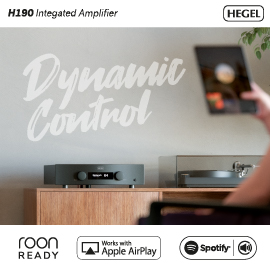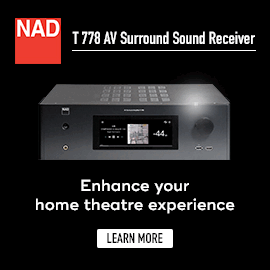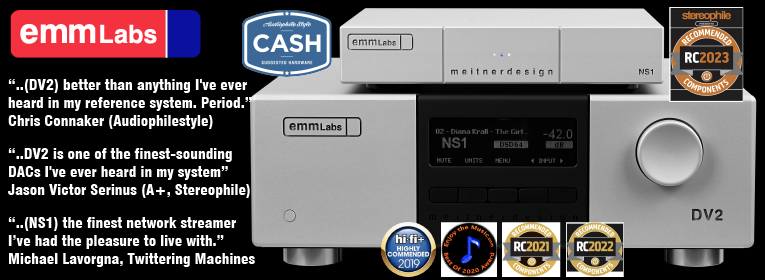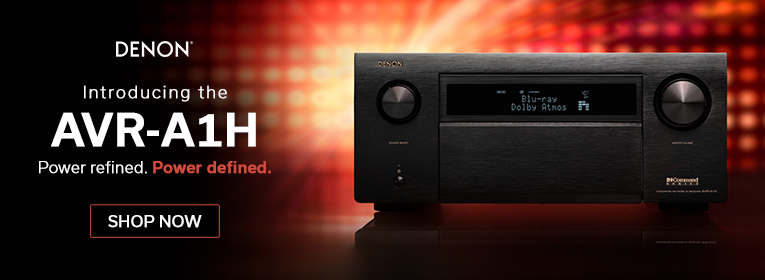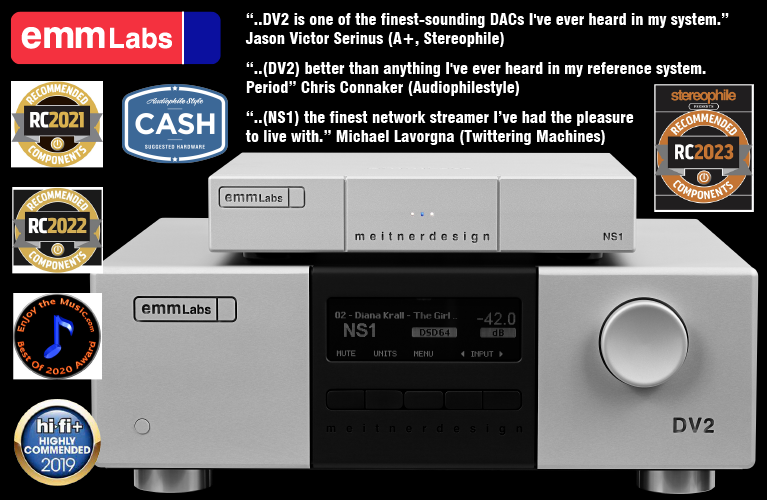Note: Measurements taken in the anechoic chamber at Canada's National Research Council can be found through this link.
 Paradigm’s previous top line of loudspeakers, the Signature models, was released more than a dozen years ago. With their high-tech drivers, high-gloss wood veneers, and many innovative features, they set a new standard for high-performance speakers at prices that, for the high end, were reasonable: from $1900 to $6000 USD per pair. Paradigm recently discontinued the Signatures, and has launched a new assault on the state of the art of speaker design: the Persona series. Featuring tweeters and midrange drivers with beryllium diaphragms, and other cutting-edge technologies, the Personas are considerable advances on the Signatures -- as is reflected in their prices, which range from $7000 to $35,000/pair.
Paradigm’s previous top line of loudspeakers, the Signature models, was released more than a dozen years ago. With their high-tech drivers, high-gloss wood veneers, and many innovative features, they set a new standard for high-performance speakers at prices that, for the high end, were reasonable: from $1900 to $6000 USD per pair. Paradigm recently discontinued the Signatures, and has launched a new assault on the state of the art of speaker design: the Persona series. Featuring tweeters and midrange drivers with beryllium diaphragms, and other cutting-edge technologies, the Personas are considerable advances on the Signatures -- as is reflected in their prices, which range from $7000 to $35,000/pair.
The flagship of the line is the Persona 9H, with four powered woofers, Anthem Room Correction (ARC) built in, and a cost of $35,000/pair. There are also several passive floorstanders, a center-channel model, a powered subwoofer, and the subject of this review: the Persona B, a passive bookshelf model. At $7000/pair, the Persona B is relatively expensive for a stand-mounted speaker, though it’s far from the most expensive bookshelf model available these days.

Creating a new persona
The Persona B is a two-way speaker with a 1” beryllium-dome tweeter, a 7” beryllium midrange-woofer, and a third-order electroacoustic crossover at 2kHz that includes parts of very high quality, says Paradigm. Although Paradigm’s ads stress the Personas’ Truextent beryllium drivers, that’s just one of many innovative design features in this line of speakers.
All of the other Persona models feature multiple woofers in addition to their beryllium midrange and tweeter. The two-way Persona B differs in having only its single midrange-woofer to reproduce low frequencies. Although, like the midrange in all of the Persona floorstanders, the Persona B’s midrange-woofer has a beryllium diaphragm, its motor structure is much more robust. It has a 1.5” split voice-coil, a large ceramic magnet, and Paradigm’s Active Ridge Technology (ART) surround, which is molded directly onto the cone. The ridges in the ART surround are designed to provide greater and more linear cone excursions, for greater output with less distortion. ART surrounds are used only on the other Personas’ woofers, not their midranges. In other words, while the Persona B’s midrange-woofer has the same beryllium diaphragm as in the other Personas, to increase its bass output it incorporates many of the design elements of those speakers’ woofers. Finally, Paradigm’s Shock-Mount system uses rubber inserts and gaskets to isolate the midrange-woofer from the cabinet, to reduce resonances. The 1” tweeter has a Truextent beryllium diaphragm, a neodymium magnet, and is encased in its own subenclosure, to isolate it from the midrange-woofer.

Few speakers have beryllium tweeters, and even fewer have beryllium midrange drivers. Beryllium is very lightweight and rigid, making it an ideal material for loudspeaker driver diaphragms. It has a higher resonant frequency than other metals used to make speaker diaphragms, and is internally damped, meaning it will ring not nearly as long, thus adding less of its own character to the sound. The Truextent beryllium diaphragms used in the Personas are made to Paradigm’s specifications by Materion, which makes beryllium components for many audio manufacturers as well as for other industries. The remainder of the driver assemblies, and pretty much everything else in each Persona speaker, is produced and assembled in Paradigm’s factory in Mississauga, Ontario.
The Persona B’s tweeter and midrange-woofer both have what Paradigm calls a Perforated Phase Alignment (PPA) lens, which works like a sophisticated phase plug and was first seen in their Prestige series. By using perforations of different sizes to block signals that are out of phase with each other, the PPA reduces the interference between such signals, resulting in smoother frequency response both on and off axis.
The Persona B measures 17.1”H x 8.9”W x 13”D and weighs 31 pounds. Its cabinet curves around at the back -- its cross section is a parabola -- and is built up of seven layers of wood composite pressed into shape and held in place by a special adhesive. The result is an enclosure deadened by constrained-layer damping. Chambered and heavily braced within, the cabinet has a rear-firing port above two sets of high-quality, all-metal binding posts suitable for biwiring or biamping.

Persona speakers are available in multiple painted finishes, including the Aria Blue of my review samples -- a metallic gloss finish of extremely high quality. The combination of a tasteful aluminum insert on the front baffle and the beautifully symmetrical PPA lenses give the Persona B a modern, elegant look -- more like artwork than an ultra-high-end bookshelf speaker.
Setup
I used the Persona Bs primarily with my Anthem Statement D2 A/V processor used as a DAC-preamplifier, and a pair of Anthem Statement M1 monaural amplifiers. They also spent time with an Oppo UDP-205 4K Ultra HD universal BD player also used as a DAC-preamp, and an NAD Masters Series M27 power amp. The rest of my system consisted of my regular assortment of cables and power conditioners, and an Asus VivoBook X200MA laptop running Windows 10, foobar2000, and Roon.
Personality traits
The Persona B had exceedingly good bass for a relatively small bookshelf speaker. It went quite low, and filled my large room with enough low frequencies to sound satisfying with whatever music I played. Most admirable about the Persona B’s bass was that it never tried to exceed its limits. Its character was always beyond reproach, with a superfast, well-defined quality, no matter what I played or how loudly I played it -- even if it couldn’t reproduce the very lowest octave.
Nearly every track of Drake’s More Life (16-bit/44.1kHz FLAC, Universal) has plenty of deep bass, along with closely miked rapping and crisp percussion. Even when Drake slightly slurs his words, his voice had a crystalline quality through the Persona B that was shockingly clear, and disarming in its neutrality and presence. When I cranked up “No Long Talk,” the voices of Drake and Giggs were placed precisely between the Persona Bs, with an astonishing clarity that let me hear the enunciation of every tiny detail of each syllable. As good as the rapping sounded, even more surprising was the bass beat, which was locked in at the absolute center of the soundstage, always totally distinct from the voices. The deeper bass of “Free Smoke” hit even harder but was equally fast, with no smearing or hint of distortion. “Glow,” with Kanye West, includes synth tones that are mostly in the upper bass and hit hard, then deftly undulate -- they demonstrated how delicately the Persona B could articulate low frequencies. I’ve heard similar amounts of bass from many small floorstanders and a few large stand-mount designs, but rarely have I heard any speaker articulate low frequencies with this much control.
If the Persona B’s bass response was excellent, its midrange and upper frequencies bordered on perfection. The mids and highs were as good as or better than any other speaker that I’ve ever heard anywhere. Their lucidity and neutrality were ultradetailed but completely natural at the same time -- they never sounded etched or harsh, but neither did they soften or obscure the sound in any way. This gave voices an unfettered quality that freed them not only from the speakers, but from all other elements of recordings. For example, Shaggy’s voice in “All Through the Night,” from Cyndi Lauper’s The Body Acoustic (16/44.1 FLAC, Sony), is processed to have a slightly muted quality; through the Persona Bs its intelligibility was exceptional, and delightfully contrasted by the strings that bounce back and forth between channels -- these sparkled, without a hint of edge or glare. Lauper’s voice flows softly and smoothly as she begins the song, then builds in a rasping crescendo that tests the resolve of any speaker. With this track or the even more demanding “True Colors,” the Persona B reproduced Lauper’s powerful singing with no sign of strain.

In “Breathe No More,” from Evanescence’s Lost Whispers (16/44.1 FLAC, The Bicycle Music Company), lead singer Amy Lee’s voice can be piercing. Through the Persona Bs it sounded sharp, but always controlled and crystal clear, and its amazingly precise image soared freely between the speakers. Painted in a hauntingly stark aural image were the gentle, melodic strains of the piano, solidly anchored at the back of an otherwise totally silent soundstage.
Listening to the Persona B over several months, I was continually amazed by its finely detailed and supremely balanced sound. I felt I was hearing everything present on every recording I played, all without the speakers drawing unnecessary attention to any imperfections in those recordings. Some familiar tracks sounded better than before, but some didn’t sound as good as I’d thought they were -- the Persona Bs revealed shortcomings that other speakers I’ve had here didn’t. These recordings didn’t sound bad through the Paradigms -- it was just that I could hear more information in them. This meant that I could now more easily assess the true nature of these recordings. The Paradigm Persona B is one of the most precisely natural-sounding speakers I have ever heard.

MartinLogan’s Masterpiece Classic ESL 9 ($6495/pair) is manufactured at the same facility in Mississauga, Ontario, as the Persona B, and costs just a bit less, but otherwise has little in common with the Paradigm. The ESL 9 is a relatively large, floorstanding, hybrid loudspeaker with a large electrostatic panel, two 8” woofers, and a nearly full-range frequency response: 34Hz-23kHz, +/-3dB to the Persona B’s 60Hz-45kHz, +/-2dB (on axis). Through the MartinLogans, the electronic beat of “Starstruck,” from Lady Gaga’s The Fame Monster (24/44.1 FLAC, Streamline/Interscope/HDtracks), was deep and superdefined, giving the track a commanding presence in my room. Through the Paradigms the beat was still there, but wasn’t as pronounced. But while the beat was at a lower level, it didn’t throw off the balance of the sound. Everything from the midbass up was all there, and there was enough low bass -- which the Persona B rolls off smoothly -- that I didn’t feel I was missing anything from most recordings. One thing the Persona B did better than the MLs with this track was reproduce the snap of the electronic handclaps. Though obviously artificial, or at least heavily processed, these claps had an astonishingly precise quality that mimicked real life in its re-creation of a very fast attack and almost no decay. They were shocking in their immediacy.
When it came to the midrange, the Persona B was one of the finest speakers I’ve heard. Rebecca Pidgeon’s voice in “Spanish Harlem,” from her The Raven: The Bob Katz 15th Anniversary Remaster (24/88.2 FLAC, Chesky/HDtracks), was perfection. With every word she sings, her inflection was clearly articulated, emerging from a stunningly silent background. Nor was there any hint of strain in the reproduction of her voice in the medley of “Auld Lang Syne” and “Bring It On Home to Me,” from her Retrospective (24/96 FLAC, Chesky/HDtracks) -- it always sounded effortless and beautifully composed, even in the intricate vocal overdubbing in the choruses.
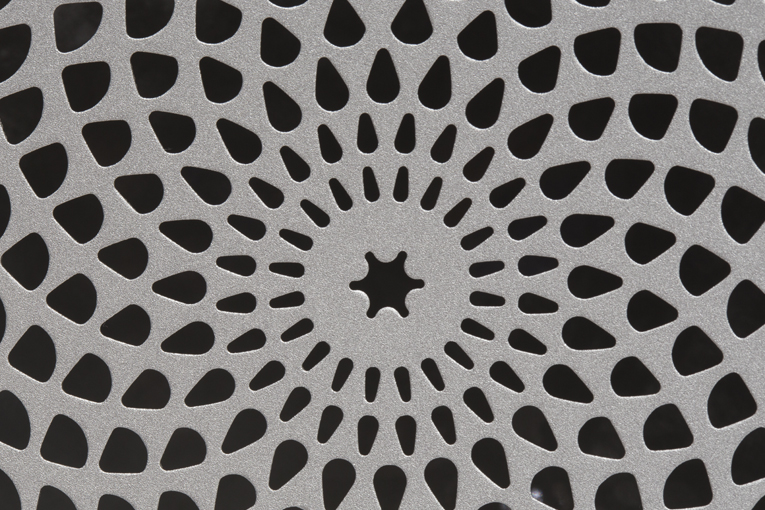
Like MartinLogan’s ESL 9, the Persona B is extremely revealing of the quality of amplification it’s given -- it made evident the ultraclean, superdetailed character of NAD’s Masters Series M27 amplifier, based on a Hypex Ncore module. When I switched to the more expensive and far more powerful Anthem Statement M1 monoblocks the Persona Bs sounded even better, with a slight, pleasing richness to the midrange, and a sparkling treble with no sign of brightness. The M1s, each of which is specified to output 1000W into 8 ohms, were able to wring more bass from the Paradigms, and play louder without strain, than the NAD M27, which outputs only 170Wpc. The Persona B doesn’t require a massively powerful, super-high-end amp to sound good, but I found that its sound incrementally benefited from the quality of amplification it was fed.
Electrostatic speakers in general and MartinLogan speakers in particular are known for their incredible midrange clarity. The Classic ESL 9 exhibited amazing transparency with Pidgeon’s overdubbed voice in “Spanish Harlem,” but sounded a little more crisp and ever so slightly less smooth and effortless than the Persona B. Both pairs of speakers produced very large soundstages with exceptional image specificity, but the Paradigm was better able to reproduce tiny changes in the placement and sound of the shaker in this track. With the ESL 9s I could easily sense changes in the speed with which the shaker was shaken, but it sounded slightly recessed in comparison. With the Persona B, not only could I hear the changes in speed, I could also more clearly make out the shaker’s position on the soundstage. I was even able to hear minute changes in the shaker’s pitch as its distance from and orientation toward the recording mike changed slightly each time it was shaken. I couldn’t do this with the ESL 9s. For its price, the MartinLogan Masterpiece Classic ESL 9 is an amazing, nearly full-range loudspeaker -- but it couldn’t match the Persona B’s precise, ultrasmooth, grain-free sound through the midrange and up through the highs, or its seemingly infinite resolution.
Strength of character
The Paradigm Persona B is ridiculously good. As a bookshelf speaker, it is naturally limited in how much low bass it can reproduce, but it can play screamingly loud with low distortion. Its midrange and treble are about as smooth and clear as those of any speaker I’ve heard at any price, and its gloriously coherent and sophisticated sound is second to none.

If you’re in the market for a state-of-the-art bookshelf speaker, look no further. You’d probably have to spend a whole lot more money to better the formidable performance of Paradigm’s Persona B -- and even then, I’m not sure you could.
. . . Roger Kanno
rogerk@soundstagenetwork.com
Associated Equipment
- Speakers -- MartinLogan Masterpiece Classic ESL 9
- Amplifiers -- Anthem Statement M1 monoblocks, NAD Masters Series M27
- Sources -- Oppo Digital UDP-205 universal BD player; Asus VivoBook X200MA computer running Windows 10, foobar2000, and Roon; Bel Canto Design mLink USB converter; AudioQuest JitterBug
- A/V processor -- Anthem Statement D2
- USB link -- AudioQuest Carbon
- Interconnects -- Analysis Plus Digital Crystal and Solo Crystal, Nordost Quattro Fil
- Speaker cables -- Analysis Plus Black Oval Nine, Nordost Super Flatline Mk.II
- Power cords -- Essential Sound Products MusicCord-Pro ES
- Power conditioners -- Blue Circle Audio PLC Thingee FX-2 with X0e low-frequency filter module, Zero Surge 1MOD15WI
Paradigm Persona B Loudspeakers
Price: $7000 USD per pair.
Warranty: Five years parts and labor.
Paradigm Electronics, Inc.
205 Annagem Blvd.
Mississauga, Ontario L5T 2V1
Canada
Phone: (905) 564-1994
Fax: (905) 564-8726
Website: www.paradigm.com





